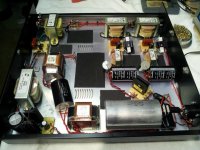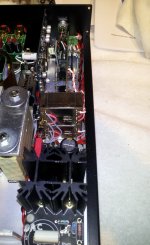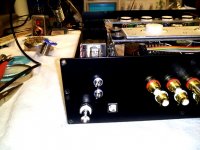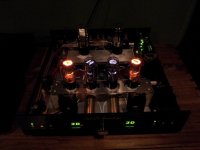When it's a DAC!
I have upgraded my 26 tube preamp into a tube output DAC/preamp by adding another power supply to the PS box and a Buffalo IIIse DAC, Sonore asynchronous USB board, and Lundahl LL1676 transformers to the preamp box.
About the sound, all I can say is WOW!
This is the missing link for me. I completely gutted and rebuilt my speakers a few years ago (Infinity RSIIb), then I built the 26 tube preamp, then I built 200wpc SET tube monoblocks, and at each step the sound improved. I still felt, however that there was something more I could get out of the sound, so I addressed the last piece of the puzzle, the source, with this project.
This new DAC has removed those last veils (audio-speak for it sounds awesome!) from the sound...I'm using my Zero One Mercury now as simply a transport, passing the 44.1kHz digital signal unfiltered to the DAC using S/PDIF with 75ohm coaxial cable and letting it do the oversampling and filtering. What a difference!
The sound is cleaner, clearer and with ZERO "digital edge". I listened for several hours yesterday and I'm hearing deeper into the recordings than ever. I think the LCLC choke input power supply with the Salas Reflektor-D and the V3.0 Trident regulators on the DAC have a lot to do with the smoothness, there is just no grain I can detect. None.
The DAC feeds the balanced output signal into Lundahl LL1676 amorphous cobalt core transformers, where the balanced output is converted to single-ended, the DAC DC offset is removed, absolute phase is flipped (to compensate for the 26 triode doing the same), the voltage is stepped down 2:1 because of the 8X gain of the 26, and the -9V battery bias is added to the secondary of the transformer (and thus the 26 grid), which is connected to the 26 control grid.
All signal wires in the DAC/preamp are solid core silver in teflon. The PS wiring is 16gauge silver coated copper in teflon for the + leg and Cardas copper litz 15.5gauge for the - leg.
I should be receiving my 50mm u.fl cables today, then I can hook up the USB board to the DAC, but I really don't have a source of USB music at this point. That's the next project...but I'm very happy with standard CDs now through this setup! How much better could high-rez be?
Pictures:
First is the starting Preamp and PS.
Second is the updated power supply. The new cLCLC choke input DAC supply is on the extreme left of the picture (12.6V split bobbin xformer into Schottky bridge with snubber into 470uF, then 10mH, 5A choke, into 22mF cap, into LDO regulator). That feeds 9.6V to a second LC stage in the preamp box (1.5mH, 10mF) which in turn feeds a Salas Reflektor-D regulator (5.25V), which feeds the onboard Trident regulators of the DAC (3.3v and 1.2V).
Third is of the DAC section of the preamp at the completion of construction.
Fourth is the back panel showing the USB and BNC connectors and the two switches. The top switch changes between S/PDIF and I2S on the DAC (for changing between S/PDIF and USB inputs), and the lower switch turns the DAC OSF on and off. Running S/PDIF, both switches go toward the BNC jack, running USB PCM both switches go toward the USB jack, running USB DSD, top switch goes toward the USB and the bottom goes toward the BNC (because the BUFFIIIse needs the OSF on to process DSD).
Fifth is of the completed DAC with the lid off during the initial testing. Pretty cool light show...
I'm fortunate that there was a lot of open room in the preamp due to the wide face plate needed for the Bent Audio display board. The DAC fits snugly, like it belongs there!
I have upgraded my 26 tube preamp into a tube output DAC/preamp by adding another power supply to the PS box and a Buffalo IIIse DAC, Sonore asynchronous USB board, and Lundahl LL1676 transformers to the preamp box.
About the sound, all I can say is WOW!
This is the missing link for me. I completely gutted and rebuilt my speakers a few years ago (Infinity RSIIb), then I built the 26 tube preamp, then I built 200wpc SET tube monoblocks, and at each step the sound improved. I still felt, however that there was something more I could get out of the sound, so I addressed the last piece of the puzzle, the source, with this project.
This new DAC has removed those last veils (audio-speak for it sounds awesome!) from the sound...I'm using my Zero One Mercury now as simply a transport, passing the 44.1kHz digital signal unfiltered to the DAC using S/PDIF with 75ohm coaxial cable and letting it do the oversampling and filtering. What a difference!
The sound is cleaner, clearer and with ZERO "digital edge". I listened for several hours yesterday and I'm hearing deeper into the recordings than ever. I think the LCLC choke input power supply with the Salas Reflektor-D and the V3.0 Trident regulators on the DAC have a lot to do with the smoothness, there is just no grain I can detect. None.
The DAC feeds the balanced output signal into Lundahl LL1676 amorphous cobalt core transformers, where the balanced output is converted to single-ended, the DAC DC offset is removed, absolute phase is flipped (to compensate for the 26 triode doing the same), the voltage is stepped down 2:1 because of the 8X gain of the 26, and the -9V battery bias is added to the secondary of the transformer (and thus the 26 grid), which is connected to the 26 control grid.
All signal wires in the DAC/preamp are solid core silver in teflon. The PS wiring is 16gauge silver coated copper in teflon for the + leg and Cardas copper litz 15.5gauge for the - leg.
I should be receiving my 50mm u.fl cables today, then I can hook up the USB board to the DAC, but I really don't have a source of USB music at this point. That's the next project...but I'm very happy with standard CDs now through this setup! How much better could high-rez be?
Pictures:
First is the starting Preamp and PS.
Second is the updated power supply. The new cLCLC choke input DAC supply is on the extreme left of the picture (12.6V split bobbin xformer into Schottky bridge with snubber into 470uF, then 10mH, 5A choke, into 22mF cap, into LDO regulator). That feeds 9.6V to a second LC stage in the preamp box (1.5mH, 10mF) which in turn feeds a Salas Reflektor-D regulator (5.25V), which feeds the onboard Trident regulators of the DAC (3.3v and 1.2V).
Third is of the DAC section of the preamp at the completion of construction.
Fourth is the back panel showing the USB and BNC connectors and the two switches. The top switch changes between S/PDIF and I2S on the DAC (for changing between S/PDIF and USB inputs), and the lower switch turns the DAC OSF on and off. Running S/PDIF, both switches go toward the BNC jack, running USB PCM both switches go toward the USB jack, running USB DSD, top switch goes toward the USB and the bottom goes toward the BNC (because the BUFFIIIse needs the OSF on to process DSD).
Fifth is of the completed DAC with the lid off during the initial testing. Pretty cool light show...
I'm fortunate that there was a lot of open room in the preamp due to the wide face plate needed for the Bent Audio display board. The DAC fits snugly, like it belongs there!
Attachments
Last edited:
Oh...I'm using the "Rasmussen Effect" and I like it!
The LL1676 transformers are set up for exactly a 1.34dB rolloff at 20kHz vs 1kHz. I set them up on my scope using a 390R output impedance from my signal generator to simulate the DAC. To get this I wired the xformer's primary and secondary in series. The primary has a 3k3 resistor between the windings, and the secondary has a 1k, 3nF snubber. Snubber cap is a REL RTE polystyrene, resistors are TX2575. I split the snubber into 500R-cap-500R.
What's neat is you can vary the rolloff easily by adjusting the size of the primary resistor - put a 5k pot there and you can dial in whatever you want.
The "Rasmussen effect" does what was claimed. The sound is crystal clear with no digital glare, yet lots of air and sparkle. Pretty cool!
The LL1676 transformers are set up for exactly a 1.34dB rolloff at 20kHz vs 1kHz. I set them up on my scope using a 390R output impedance from my signal generator to simulate the DAC. To get this I wired the xformer's primary and secondary in series. The primary has a 3k3 resistor between the windings, and the secondary has a 1k, 3nF snubber. Snubber cap is a REL RTE polystyrene, resistors are TX2575. I split the snubber into 500R-cap-500R.
What's neat is you can vary the rolloff easily by adjusting the size of the primary resistor - put a 5k pot there and you can dial in whatever you want.
The "Rasmussen effect" does what was claimed. The sound is crystal clear with no digital glare, yet lots of air and sparkle. Pretty cool!
Fantastic, beautiful, incredible project!! Wonderful job, it looks amazing!
😀 😀 😀
When properly done? Staggeringly better...
😀 😀 😀
How much better could high-rez be?
When properly done? Staggeringly better...
One more thing. I put in a relay circuit to switch between use as a preamp and as a DAC. It uses 9V telecom relays powered by the DAC power supply. When the DAC power is switched on it disconnects the normal 6-RCA input board and it's input transformers from the 26 grid and connects the DAC output instead, through the DAC's LL1676s. Works great.
Fantastic, beautiful, incredible project!! Wonderful job, it looks amazing!
😀 😀 😀
When properly done? Staggeringly better...
Thanks! Guess I'll find that out about High rez next, once I set up a music server of some sort. Thinking about a Mac Mini with an i-pad as the remote. Lots of possibilities...but at least I have the USB input DAC ready to go!
The primary has a 3k3 resistor between the windings, and the secondary has a 1k, 3nF snubber. Snubber cap is a REL RTE polystyrene, resistors are TX2575. I split the snubber into 500R-cap-500R.
Did you used Quasimodo jig to know the snubbers values?
Did you used Quasimodo jig to know the snubbers values?
Quasimodo for an interstage transformer?
All you need is a signal generator and a scope. I use them to get the best square wave performance from the transformer first, then look at sine waves and dial in the primary resistance until I achieve the desired rolloff at 20kHz. Then I recheck the square wave to make sure that's still good.
As I said, for the LL1676 wired 2:1 in series, 3k3 on the primary and 3nf/1k on the secondary will give you the correct rolloff with a Buffalo IIIse, while maintaining a good looking square wave.
You don't used, my advice is make one & make the measurement for exact snubbers value.
Quasimodo link: http://www.diyaudio.com/forums/power-supplies/243100-simple-no-math-transformer-snubber-using-quasimodo-test-jig.html
CheapoModo link: http://www.diyaudio.com/forums/power-supplies/250582-cheapomodo-quick-dirty-transformer-snubber-bellringer-jig.html#post3806422
Quasimodo link: http://www.diyaudio.com/forums/power-supplies/243100-simple-no-math-transformer-snubber-using-quasimodo-test-jig.html
CheapoModo link: http://www.diyaudio.com/forums/power-supplies/250582-cheapomodo-quick-dirty-transformer-snubber-bellringer-jig.html#post3806422
Quasimodo for an interstage transformer?
All you need is a signal generator and a scope. I use them to get the best square wave performance from the transformer first, then look at sine waves and dial in the primary resistance until I achieve the desired rolloff at 20kHz. Then I recheck the square wave to make sure that's still good.
As I said, for the LL1676 wired 2:1 in series, 3k3 on the primary and 3nf/1k on the secondary will give you the correct rolloff with a Buffalo IIIse, while maintaining a good looking square wave.
When you have that equipment it is possible and better to hand wind your own i/v transformers as the audiophile ones are priced out of all reason.
- Status
- Not open for further replies.
- Home
- Source & Line
- Digital Line Level
- When is a Preamp Not a Preamp?




